- 31 lockers will remain open.
Construct a table. The perfect squares 1, 4, 9, 16, 25, ..., 961
will be the open lockers.
- 99 guests enter on the 50th ring, and there are 2,500 guests present.
Use a table for the ring, the number of guests entering,
and the total guests, and then look for a pattern.
Ring #
Guests
Total
1
1
1
2
3
4
3
5
9
4
7
16
5
9
25
6
11
36
n
2n-1
n2
50
99
2500
-
There are 364 gifts. Click here for an explanation.
- There are 28 handshakes.
Draw an octagon.
Use the formula (n(n-3))/2, which gives you the total number of diagonals,
and then add n to it (for the number of sides of the polygon).
- There are 204 squares.
Use a chart:
Dimensions of the square
Number of Squares
1 x 1
64
2 x 2
49
3 x 3
36
4 x 4
25
5 x 5
16
6 x 6
9
7 x 7
4
8 x 8
1
- There are 2 rectangles: 4 x 4 and 6 x 3.
Solve 2a + 2b = ab.
- He has 30 pigs and 40 chickens.
Solve: 1p + 1 c = 70 and 4p + 2c = 200 simultaneously.
- 12.2 mph.

- They didn't play each other.
- Pay on the last day is over $5 million, and the total is over $10 million.
Click here to see the computation.
- There would be 220 or 1,048,576 sheets of paper,
and the pile would be 1,048 inches or 87 feet tall.
Click here for more information.
- 49 games.
There is one winner, so there must be 49 losers, and hence, 49 games played.
- Point X must be 50 yards from C and 80 yards from D.
The minimum distance is 183.8 yards.
- You need 9 coins.
4 pennies, 1 nickel, 2 dimes, 1 quarter, 1 half dollar, or
4 pennies, 2 nickels, 1 dime, 1 quarter, 1 half dollar.
- Five crossings are needed.
(1) Send 3 cannibals across.
(2) Then 1 cannibal comes back.
(3) Then 3 missionaries row across.
(4) Then 1 missionary comes back.
(5) The missionary and cannibal row across.
- The smallest number is 25.
The least common multiple of 2, 3, and 4 is 12.
Add 1. The sequence is 13, 25, 37, 49, ...
- The sum of the reciprocals is 2/3.
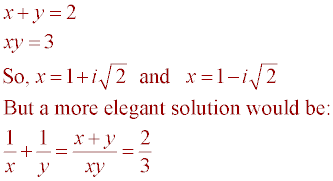
- The ages of the three children are 3, 3, and 8.
First, list all 12 sets of factor triples that equal 72:
1 x 1 x 72 sum = 74
1 x 2 x 36 sum = 39
1 x 3 x 24 sum = 28
1 x 4 x 18 sum = 23
1 x 6 x 12 sum = 19
1 x 8 x 9 sum = 18
2 x 2 x 18 sum = 22
2 x 3 x 12 sum = 17
2 x 4 x 9 sum = 15
2 x 6 x 6 sum = 14
3 x 3 x 8 sum = 14
3 x 4 x 6 sum = 13
There are two sums that equal 14, and that is why the census taker couldn't tell.
So, the additional clue about apple pie tells the census taker that there is one oldest child.
Hence, the ages are 3, 3, and 8, and not 2, 6, and 6.
The house number is 14.
- The fish was 72 inches long.
Let b = length of body.
Let t = length of tail.
then t = 9 + 1/2 b and b = 9 + t.
Solving simultaneously, b = 36" and t = 27".
- x = 1 and 7.
Solving the equation gives you x = 1, but remember that 11 = -1 in base 12.
- The largest number is 97.
- The two numbers are 96,420 and 87,531 with a product of 8,439,739,020.
Use two principles:
(1) The largest digits go to the left and
(2) the product of 2 numbers will be maximized if their difference is as small as possible.
- There were 27 coconuts in the original pile.
The first sailor took 9 coconuts, leaving 18.
The second sailor took 6 coconuts, leaving 12.
The third sailor took 4 coconuts, leaving 8.
- James had the better average for the first week (5/11 = .454 to 3/7 = .428).
James had the better average for the second week (6/9 = .667 to 9/14 = .642).
However, even though James had a better average for each week,
Jackson had the better overall average (12/21 = .571 to 11/20 = .550)!
- The answer is 1.59 feet off the ground!
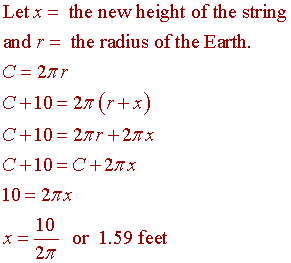
- Your head travels 37.7 feet farther than your feet.
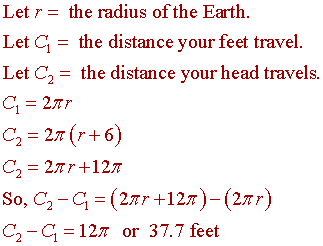
- There are 252 different ways.
Use an adaptation of Pascal's triangle:
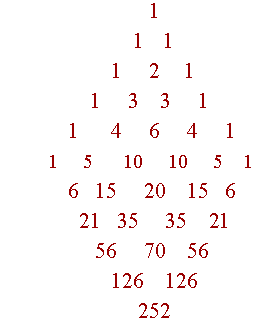
- It is not possible to average 60 mph no matter how fast you come back.
If the distance from New York to Chicago is 900 miles,
then it would take 30 hours to get there at 30 mph.
To average 60 mph over the whole trip of 1,800 miles,
you would have to make the trip in 30 hours,
but you already used 30 hours going there,
so you would have to make the return trip in zero hours.
- The average speed is 13.333 mph.
Let the distance up the hill be 20 miles.
Then it took 2 hours to go up and 1 hour to come back down.
So, the average speed is found by dividing total distance (40 miles) by total time (3 hours).
- The value is 1.
Use reciprocal identities or sin x csc x = 1, cos x sec x = 1, and tan x cot x = 1.
- The commuter had been walking 55 minutes.
From the point of view of the wife:
The car has been going 5 minutes less in each direction.
The husband had been walking 55 minutes.
- They are 49, 10, and 5 years old.
Begin by looking at all the factors whose product is 2,450.
Then look at the sums of those factors.
Factors of 2,450
Sum of Factors
1-49-50
100
2-25-49
76
2-35-35
72
5-5-98
108
5-7-70
102
5-10-49
64
5-14-35
54
7-7-50
64
7-14-25
46
7-10-35
52
Since Edie cannot figure out the ages at first,
it must be because there are two sums equal to twice her age.
5 + 10 +49 = 64 and 7 + 7 + 50 = 64, so Edie must be 32.
When Dave gives the final clue, it reveals that he is 50,
and therefore, the three ages that work are 5, 10, and 49.
- The fly travels 40 miles.
The bike riders will collide in one hour
since they are going toward each other at a combined 25 mph.
- The answer is 496 phone lines.
Use this formula: n + n(n - 3)/2, where n is the number of teams.
Visualize an n-sided polygon, with n(n - 3)/2 diagonals.
- A team cannot score 1, 2, 4, 5, 8, and 11 points.
- The catcher and the umpire.
- The bear is white.
He must have started from the North Pole.
- The man started at a point less than 10 miles from the North Pole.
First, he headed north and walked 10 miles,
passing over the pole and continuing for some distance.
Then he turned around, headed north again,
and walked 10 more miles.
- It will take 6 days.
At the end of the first 5 days, he will have climbed 5 feet.
Then on the 6th day, he will climb to 10 feet and be out!
- The last room number is 745.
Subtract each individual digit in the room number from 10 to crack the code.
- It is 341/20 = 17.05 cm.
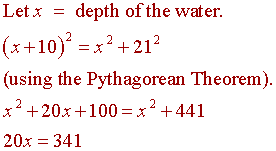
- Statement 3 is true.
Statement 1 is obviously true.
So, statement 2 must be false --
if it were true, it would be a contradiction
(two statements must not be false).
Therefore, statement 3 must be true.
- Paul plays the guitar,
John plays the drums,
George plays the piano.
- The list contains the states appearing in the names of avenues on a Monopoly Board
in the order they are encountered traveling around the board.
- The children's ages are 2, 2, and 9, and the address is 13.
The following are the only combinations of three ages whose product is 36:
1x1x36 2x2x9 1x3x12 1x2x18
1x6x6 2x3x6 1x4x9 3x3x4
Except for two of the combinations, their sums are all different,
so the census worker would have been able to determine the ages of
the children if the address next door had been any of those six different ones.
As she needed more information, the address must have been 13,
a total shared by two combinations: 1, 6, 6, and 2, 2, 9.
So, when the mother indicated that there was an oldest child,
she eliminated the first combination, which had two "oldest,"
leaving only 2, 2, 9 as the answer.
- The minimum number of pitches is 25.
He is the losing pitcher and he is playing away from home.
He retires the first 24 batters on 1 pitch each (3 pitches per inning)
and then the first batter up in the ninth inning hits a homerun to win the game, 1-0.
In March 2015, Craig Clarke (a Math teacher & amateur baseball umpire) sent the following:
I believe the theoretical minimum is 9 pitches:
First batter hits a triple on the first pitch of the game. Before the next pitch is thrown, the first batter, now on third, attempts to steal home. The batter interferes with the catcher trying to get out of the catcher's box. Batter is out for interference (rule 6.06(b)). This batter's interference occurs two more times in the first inning. The same scenario plays out for the next eight innings. Nine pitches total.
Obviously this would never happen, but still the theoretical minimum, I believe.
Here is the Major League Baseball Rule 6.06
A batter is out for illegal action when --
(a) He hits a ball with one or both feet on the ground entirely outside the batter?s box.
Rule 6.06(a) Comment: If a batter hits a ball fair or foul while out of the batter?s box, he shall be called out. Umpires should pay particular attention to the position of the batter?s feet if he attempts to hit the ball while he is being intentionally passed. A batter cannot jump or step out of the batter?s box and hit the ball.
(b) He steps from one batter?s box to the other while the pitcher is in position ready to pitch;
(c) He interferes with the catcher?s fielding or throwing by stepping out of the batter?s box or making any other movement that hinders the catcher?s play at home base. EXCEPTION: Batter is not out if any runner attempting to advance is put out, or if runner trying to score is called out for batter?s interference.
Rule 6.06(c) Comment: If the batter interferes with the catcher, the plate umpire shall call ?interference.? The batter is out and the ball dead. No player may advance on such interference (offensive interference) and all runners must return to the last base that was, in the judgment of the umpire, legally touched at the time of the interference.
If, however, the catcher makes a play and the runner attempting to advance is put out, it is to be assumed there was no actual interference and that runner is out?not the batter. Any other runners on the base at the time may advance as the ruling is that there is no actual interference if a runner is retired. In that case play proceeds just as if no violation had been called.
If a batter strikes at a ball and misses and swings so hard he carries the bat all the way around and, in the umpire?s judgment, unintentionally hits the catcher or the ball in back of him on the backswing before the catcher has securely held the ball, it shall be called a strike only (not interference). The ball will be dead, however, and no runner shall advance on the play.
(d) He uses or attempts to use a bat that, in the umpire?s judgment, has been altered or tampered with in such a way to improve the distance factor or cause an unusual reaction on the baseball. This includes, bats that are filled, flat-surfaced, nailed, hollowed, grooved or covered with a substance such as paraffin, wax, etc.
No advancement on the bases will be allowed and any out or outs made during a play shall stand.
In addition to being called out, the player shall be ejected from the game and may be subject to additional penalties as determined by his League President.
Rule 6.06(d) Comment: A batter shall be deemed to have used or attempted to use an illegal bat if he brings such a bat into the batter's box.
- The answer is $13.
- There are 22 birds and 14 beasts.
Let A = number of birds and B = the number of beasts.
Then A + B = 36 and 2A + 4B = 100
- The student must get 104 questions correct with 16 wrong answers
(104 - 1/4(16) = 100).
- The third child would get $3,456.
- There are 1,024 pages in the book.
A book of 999 pages needs 1(9) + 2(90) + 3(900) or 2,889 digits.
A book of x pages needs 2889 + 4(x - 999) = 2989
Therefore, x = 1024.
- The total trip is 2,772 miles (1,386 miles each way).
Let x = time at which he travels 55 mph, so the distance is 55x.
Then 45 - x is the number of hours at which he traveled 70 mph.
So the return distance is 70(45-x).
Set 70(45-x) = 55x and solve for x.
x = 25.2 hours.
- There are 120 lilies.
Let x = number of lilies.
Then, 1/3 x + 1/5 x + 1/6 x + 1/4 x + 6 = x
- There were 15 bees.
- Subtract the second number from the first. Then add both numbers for the remaining digits.
-
The correct answer is (A) YES.
Why is this question so tricky? It is because it appears to give you insufficient information.
Anne’s marital status is not known, nor can it be determined, and so you make the inference that the question posed cannot be determined.
In fact, Anne’s marital status is irrelevant to the answer.
If she is married, then a married person is looking at an unmarried person (Anne is looking at George), and if she isn’t, a married person is looking at an unmarried person (Jack is looking at Anne).
Written down it becomes more obvious. If ‘>’ means ‘looking at’ then:
Jack > Anne > George, or
Married > Unknown > Unmarried
Replace Unkown with Married or with Unmarried and either way there is clearly a married person looking at an unmarried one.
Construct a table. The perfect squares 1, 4, 9, 16, 25, ..., 961 will be the open lockers.
Use a table for the ring, the number of guests entering,
and the total guests, and then look for a pattern.
| Ring # | Guests | Total |
|---|---|---|
| 1 | 1 | 1 |
| 2 | 3 | 4 |
| 3 | 5 | 9 |
| 4 | 7 | 16 |
| 5 | 9 | 25 |
| 6 | 11 | 36 |
| n | 2n-1 | n2 |
| 50 | 99 | 2500 |
Draw an octagon.
Use the formula (n(n-3))/2, which gives you the total number of diagonals, and then add n to it (for the number of sides of the polygon).
Use a chart:
| Dimensions of the square | Number of Squares | |
|---|---|---|
| 1 x 1 | 64 | |
| 2 x 2 | 49 | |
| 3 x 3 | 36 | |
| 4 x 4 | 25 | |
| 5 x 5 | 16 | |
| 6 x 6 | 9 | |
| 7 x 7 | 4 | |
| 8 x 8 | 1 |
Solve 2a + 2b = ab.
Solve: 1p + 1 c = 70 and 4p + 2c = 200 simultaneously.

Click here to see the computation.
and the pile would be 1,048 inches or 87 feet tall.
Click here for more information.
There is one winner, so there must be 49 losers, and hence, 49 games played.
The minimum distance is 183.8 yards.
4 pennies, 1 nickel, 2 dimes, 1 quarter, 1 half dollar, or
4 pennies, 2 nickels, 1 dime, 1 quarter, 1 half dollar.
(1) Send 3 cannibals across.
(2) Then 1 cannibal comes back.
(3) Then 3 missionaries row across.
(4) Then 1 missionary comes back.
(5) The missionary and cannibal row across.
The least common multiple of 2, 3, and 4 is 12.
Add 1. The sequence is 13, 25, 37, 49, ...

First, list all 12 sets of factor triples that equal 72:
1 x 1 x 72 sum = 74
1 x 2 x 36 sum = 39
1 x 3 x 24 sum = 28
1 x 4 x 18 sum = 23
1 x 6 x 12 sum = 19
1 x 8 x 9 sum = 18
2 x 2 x 18 sum = 22
2 x 3 x 12 sum = 17
2 x 4 x 9 sum = 15
2 x 6 x 6 sum = 14
3 x 3 x 8 sum = 14
3 x 4 x 6 sum = 13
There are two sums that equal 14, and that is why the census taker couldn't tell.
So, the additional clue about apple pie tells the census taker that there is one oldest child.
Hence, the ages are 3, 3, and 8, and not 2, 6, and 6.
The house number is 14.
Let b = length of body.
Let t = length of tail.
then t = 9 + 1/2 b and b = 9 + t.
Solving simultaneously, b = 36" and t = 27".
Solving the equation gives you x = 1, but remember that 11 = -1 in base 12.
Use two principles:
(1) The largest digits go to the left and
(2) the product of 2 numbers will be maximized if their difference is as small as possible.
The first sailor took 9 coconuts, leaving 18.
The second sailor took 6 coconuts, leaving 12.
The third sailor took 4 coconuts, leaving 8.
James had the better average for the second week (6/9 = .667 to 9/14 = .642).
However, even though James had a better average for each week,
Jackson had the better overall average (12/21 = .571 to 11/20 = .550)!


Use an adaptation of Pascal's triangle:

If the distance from New York to Chicago is 900 miles,
then it would take 30 hours to get there at 30 mph.
To average 60 mph over the whole trip of 1,800 miles,
you would have to make the trip in 30 hours,
but you already used 30 hours going there,
so you would have to make the return trip in zero hours.
Let the distance up the hill be 20 miles.
Then it took 2 hours to go up and 1 hour to come back down.
So, the average speed is found by dividing total distance (40 miles) by total time (3 hours).
Use reciprocal identities or sin x csc x = 1, cos x sec x = 1, and tan x cot x = 1.
From the point of view of the wife:
The car has been going 5 minutes less in each direction.
The husband had been walking 55 minutes.
Begin by looking at all the factors whose product is 2,450.
Then look at the sums of those factors.
| Factors of 2,450 | Sum of Factors |
|---|---|
| 1-49-50 | 100 |
| 2-25-49 | 76 |
| 2-35-35 | 72 |
| 5-5-98 | 108 |
| 5-7-70 | 102 |
| 5-10-49 | 64 |
| 5-14-35 | 54 |
| 7-7-50 | 64 |
| 7-14-25 | 46 |
| 7-10-35 | 52 |
Since Edie cannot figure out the ages at first,
it must be because there are two sums equal to twice her age.
5 + 10 +49 = 64 and 7 + 7 + 50 = 64, so Edie must be 32.
When Dave gives the final clue, it reveals that he is 50,
and therefore, the three ages that work are 5, 10, and 49.
The bike riders will collide in one hour
since they are going toward each other at a combined 25 mph.
Use this formula: n + n(n - 3)/2, where n is the number of teams.
Visualize an n-sided polygon, with n(n - 3)/2 diagonals.
He must have started from the North Pole.
First, he headed north and walked 10 miles,
passing over the pole and continuing for some distance.
Then he turned around, headed north again,
and walked 10 more miles.
At the end of the first 5 days, he will have climbed 5 feet.
Then on the 6th day, he will climb to 10 feet and be out!
Subtract each individual digit in the room number from 10 to crack the code.

Statement 1 is obviously true.
So, statement 2 must be false --
if it were true, it would be a contradiction
(two statements must not be false).
Therefore, statement 3 must be true.
John plays the drums,
George plays the piano.
in the order they are encountered traveling around the board.
The following are the only combinations of three ages whose product is 36:
1x1x36 2x2x9 1x3x12 1x2x18
1x6x6 2x3x6 1x4x9 3x3x4
Except for two of the combinations, their sums are all different,
so the census worker would have been able to determine the ages of
the children if the address next door had been any of those six different ones.
As she needed more information, the address must have been 13,
a total shared by two combinations: 1, 6, 6, and 2, 2, 9.
So, when the mother indicated that there was an oldest child,
she eliminated the first combination, which had two "oldest,"
leaving only 2, 2, 9 as the answer.
He is the losing pitcher and he is playing away from home.
He retires the first 24 batters on 1 pitch each (3 pitches per inning)
and then the first batter up in the ninth inning hits a homerun to win the game, 1-0.
In March 2015, Craig Clarke (a Math teacher & amateur baseball umpire) sent the following:
I believe the theoretical minimum is 9 pitches:
First batter hits a triple on the first pitch of the game. Before the next pitch is thrown, the first batter, now on third, attempts to steal home. The batter interferes with the catcher trying to get out of the catcher's box. Batter is out for interference (rule 6.06(b)). This batter's interference occurs two more times in the first inning. The same scenario plays out for the next eight innings. Nine pitches total.
Obviously this would never happen, but still the theoretical minimum, I believe.
Here is the Major League Baseball Rule 6.06
A batter is out for illegal action when --
(a) He hits a ball with one or both feet on the ground entirely outside the batter?s box.
Rule 6.06(a) Comment: If a batter hits a ball fair or foul while out of the batter?s box, he shall be called out. Umpires should pay particular attention to the position of the batter?s feet if he attempts to hit the ball while he is being intentionally passed. A batter cannot jump or step out of the batter?s box and hit the ball.
(b) He steps from one batter?s box to the other while the pitcher is in position ready to pitch;
(c) He interferes with the catcher?s fielding or throwing by stepping out of the batter?s box or making any other movement that hinders the catcher?s play at home base. EXCEPTION: Batter is not out if any runner attempting to advance is put out, or if runner trying to score is called out for batter?s interference. Rule 6.06(c) Comment: If the batter interferes with the catcher, the plate umpire shall call ?interference.? The batter is out and the ball dead. No player may advance on such interference (offensive interference) and all runners must return to the last base that was, in the judgment of the umpire, legally touched at the time of the interference.
If, however, the catcher makes a play and the runner attempting to advance is put out, it is to be assumed there was no actual interference and that runner is out?not the batter. Any other runners on the base at the time may advance as the ruling is that there is no actual interference if a runner is retired. In that case play proceeds just as if no violation had been called.
If a batter strikes at a ball and misses and swings so hard he carries the bat all the way around and, in the umpire?s judgment, unintentionally hits the catcher or the ball in back of him on the backswing before the catcher has securely held the ball, it shall be called a strike only (not interference). The ball will be dead, however, and no runner shall advance on the play.
(d) He uses or attempts to use a bat that, in the umpire?s judgment, has been altered or tampered with in such a way to improve the distance factor or cause an unusual reaction on the baseball. This includes, bats that are filled, flat-surfaced, nailed, hollowed, grooved or covered with a substance such as paraffin, wax, etc. No advancement on the bases will be allowed and any out or outs made during a play shall stand.
In addition to being called out, the player shall be ejected from the game and may be subject to additional penalties as determined by his League President. Rule 6.06(d) Comment: A batter shall be deemed to have used or attempted to use an illegal bat if he brings such a bat into the batter's box.
Let A = number of birds and B = the number of beasts.
Then A + B = 36 and 2A + 4B = 100
(104 - 1/4(16) = 100).
A book of 999 pages needs 1(9) + 2(90) + 3(900) or 2,889 digits.
A book of x pages needs 2889 + 4(x - 999) = 2989
Therefore, x = 1024.
Let x = time at which he travels 55 mph, so the distance is 55x.
Then 45 - x is the number of hours at which he traveled 70 mph.
So the return distance is 70(45-x).
Set 70(45-x) = 55x and solve for x.
x = 25.2 hours.
Let x = number of lilies.
Then, 1/3 x + 1/5 x + 1/6 x + 1/4 x + 6 = x
Why is this question so tricky? It is because it appears to give you insufficient information.
Anne’s marital status is not known, nor can it be determined, and so you make the inference that the question posed cannot be determined.
In fact, Anne’s marital status is irrelevant to the answer.
If she is married, then a married person is looking at an unmarried person (Anne is looking at George), and if she isn’t, a married person is looking at an unmarried person (Jack is looking at Anne).
Written down it becomes more obvious. If ‘>’ means ‘looking at’ then:
Jack > Anne > George, or
Married > Unknown > Unmarried
Replace Unkown with Married or with Unmarried and either way there is clearly a married person looking at an unmarried one.